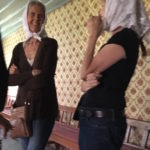 Shortly before the end of a trip through the beautiful Transcaucasian Republic of Georgia, a friend remembered having heard about a small pacifist community of Doukhobors there. In faith, they reject icons, crosses, priestly intermediaries, and church rituals. At birth, marriage, and death they conduct simple rituals. Sensing that God is everywhere and in everything, they consider every person a temple, and their spiritual leaders have often been women. In the 1830s, rejecting Russian Orthodoxy, burning their weapons of war, and refusing to join Nicholas I’s army, around 5,000 Doukhobors resettled in Georgia. Today, the Doukhobor community in Georgia has just over 130 members remaining in the villages of Orlovka and Gorelovka—sacred places for Doukhobors around the world.
Shortly before the end of a trip through the beautiful Transcaucasian Republic of Georgia, a friend remembered having heard about a small pacifist community of Doukhobors there. In faith, they reject icons, crosses, priestly intermediaries, and church rituals. At birth, marriage, and death they conduct simple rituals. Sensing that God is everywhere and in everything, they consider every person a temple, and their spiritual leaders have often been women. In the 1830s, rejecting Russian Orthodoxy, burning their weapons of war, and refusing to join Nicholas I’s army, around 5,000 Doukhobors resettled in Georgia. Today, the Doukhobor community in Georgia has just over 130 members remaining in the villages of Orlovka and Gorelovka—sacred places for Doukhobors around the world.
After reading articles about the hardships the community has faced, we decided to shift our focus towards something more expansive than our own adventures, and seek the ‘experience of spirits being human,’ as someone once described it. We found a few names to track down and headed to Gorelovka, hoping to offer some good cheer as well as school supplies and clothing for the children.
The main road through town toward the Armenian border is a rutted dirt path with mostly dilapidated sod-roofed homes with whitewashed walls and carved wooden shutters in cheerful shades of blue. We pulled up to the only school in town. After a lengthy struggle with the language barrier, we were introduced to a lady who preserves the museum and church. She knew and told us of the families with children that could use help.
The Doukhobors we met were in the middle of a potato harvest. In this sparse climate, potatoes are a cash crop that can be exchanged for other goods (see the 2017 short documentary The Trader for a fascinating glimpse into this culture). The woman who became our guide to the twenty of so families in need first took us to visit the traditional gathering place for the community. It was a single-story building with a fence and walls painted in several shades of blue and lavender, the traditional Doukhobor colors. She took us inside, after pausing to hand out scarves for the women to use to cover their heads.

Once inside, we saw a comfortable and immaculate room with benches along the walls and a large furnace to keep the room heated in the windswept and often cold Anatolian climate. The reverence she felt for her tradition was evident as the minutes passed and our differences melted in mutual appreciation of collective regard for something greater than ‘I’. When we returned outside, seeing that the building was in need of fresh paint, we offered to donate new paint. She was delighted and animated as we collected a handful of fading chips of peeling lavender and blue.
 The next day she took us around, introducing us to the families and children for whom we had new clothes and packets of school supplies. It was quite something to see the shy, yet interested children watch us coming to up their ho
The next day she took us around, introducing us to the families and children for whom we had new clothes and packets of school supplies. It was quite something to see the shy, yet interested children watch us coming to up their ho mes. On our final stop we met a young girl who was wearing a well-worn puffy white dress, a decorative headband, and faded “Frozen” slippers. She was curious, then incredulous as we showed her the school supplies, and held up each colorful new piece of clothing for her wide-eyed, bright-smiling nod of approval as we passed it to her mother. It was one day I suspect this fairy princess will never forget, nor will we.
mes. On our final stop we met a young girl who was wearing a well-worn puffy white dress, a decorative headband, and faded “Frozen” slippers. She was curious, then incredulous as we showed her the school supplies, and held up each colorful new piece of clothing for her wide-eyed, bright-smiling nod of approval as we passed it to her mother. It was one day I suspect this fairy princess will never forget, nor will we.

